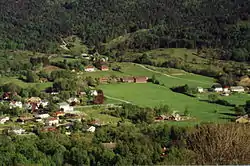Vikebygd Municipality
Vikebygd herad | |
|---|---|
 View of the village of Vikebygd | |
 Hordaland within Norway | |
 Vikebygd within Hordaland | |
| Coordinates: 59°35′39″N 05°35′14″E / 59.59417°N 5.58722°E | |
| Country | Norway |
| County | Hordaland |
| District | Sunnhordland |
| Established | 1 Jan 1902 |
| • Preceded by | Sveen Municipality |
| Disestablished | 1 Jan 1964 |
| • Succeeded by | Ølen and Sveio municipalities |
| Administrative centre | Vikebygd |
| Area (upon dissolution) | |
| • Total | 102 km2 (39 sq mi) |
| Population (1963) | |
| • Total | 1,049 |
| • Density | 10/km2 (27/sq mi) |
| Time zone | UTC+01:00 (CET) |
| • Summer (DST) | UTC+02:00 (CEST) |
| ISO 3166 code | NO-1215[1] |
Vikebygd is a former municipality in the old Hordaland county, Norway. The municipality existed from 1902 until its dissolution in 1964. It was located along the eastern and western shores of the Ålfjorden, a small branch off the main Hardangerfjorden. The 102-square-kilometre (39 sq mi) municipality is located in the present-day municipalities of Sveio (in Hordaland county) and in Vindafjord (in Rogaland county). The administrative centre of the municipality was the village of Vikebygd, where Vikebygd Church is located.[2]
History
Historically, the parish of Vikebygd was a part of the old municipality of Fjeldberg. In 1865, Vikebygd parish became a part of the new municipality of Sveen. On 1 January 1902, the eastern part of the municipality of Sveen was separated to form the new municipality of Vikebygd. Initially, Vikebygd had a population of 1,092.[3]
During the 1960s, there were many municipal mergers across Norway due to the work of the Schei Committee. On 1 January 1964, the municipality of Vikebygd was dissolved. Using Ålfjorden as a dividing line the western part of Vikebygd (population: 471) was merged into the neighboring municipality of Sveio and the eastern part (population: 578) was merged into the neighboring municipality of Ølen. On 1 January 2006, all of Ølen municipality was incorporated into Vindafjord municipality in Rogaland county.[3]
Name
The municipality (originally the parish) is named after the old Vik farm (Old Norse: Víkr). The first element is the plural genitive case vík which means "bay" or "cove". The last element was added as a suffix. It comes from the word byggð which means "settlement" or "inhabited area".[4]
Government
During its existence, this municipality was governed by a municipal council of directly elected representatives. The mayor was indirectly elected by a vote of the municipal council.[5]
Municipal council
The municipal council (Heradsstyre) of Vikebygd was made up of 17 representatives who were elected to four year terms. The party breakdown of the final municipal council was as follows:
| Party name (in Nynorsk) | Number of representatives | |
|---|---|---|
| Labour Party (Arbeidarpartiet) | 2 | |
| Local List(s) (Lokale lister) | 15 | |
| Total number of members: | 17 | |
| Party name (in Nynorsk) | Number of representatives | |
|---|---|---|
| Labour Party (Arbeidarpartiet) | 3 | |
| Local List(s) (Lokale lister) | 14 | |
| Total number of members: | 17 | |
| Party name (in Nynorsk) | Number of representatives | |
|---|---|---|
| Labour Party (Arbeidarpartiet) | 2 | |
| Local List(s) (Lokale lister) | 14 | |
| Total number of members: | 16 | |
| Party name (in Nynorsk) | Number of representatives | |
|---|---|---|
| Labour Party (Arbeidarpartiet) | 2 | |
| Local List(s) (Lokale lister) | 14 | |
| Total number of members: | 16 | |
| Party name (in Nynorsk) | Number of representatives | |
|---|---|---|
| Labour Party (Arbeidarpartiet) | 3 | |
| Local List(s) (Lokale lister) | 13 | |
| Total number of members: | 16 | |
| Party name (in Nynorsk) | Number of representatives | |
|---|---|---|
| Labour Party (Arbeidarpartiet) | 1 | |
| Local List(s) (Lokale lister) | 15 | |
| Total number of members: | 16 | |
| Note: Due to the German occupation of Norway during World War II, no elections were held for new municipal councils until after the war ended in 1945. | ||
See also
References
- ↑ Bolstad, Erik; Thorsnæs, Geir, eds. (26 January 2023). "Kommunenummer". Store norske leksikon (in Norwegian). Kunnskapsforlaget.
- ↑ Store norske leksikon. "Vikebygd" (in Norwegian). Retrieved 5 March 2015.
- 1 2 Jukvam, Dag (1999). Historisk oversikt over endringer i kommune- og fylkesinndelingen (PDF) (in Norwegian). Statistisk sentralbyrå. ISBN 9788253746845.
- ↑ Rygh, Oluf (1910). Norske gaardnavne: Søndre Bergenhus amt (in Norwegian) (11 ed.). Kristiania, Norge: W. C. Fabritius & sønners bogtrikkeri. p. 100.
- ↑ Hansen, Tore; Vabo, Signy Irene, eds. (20 September 2022). "kommunestyre". Store norske leksikon (in Norwegian). Kunnskapsforlaget. Retrieved 1 January 2023.
- ↑ "Kommunevalgene og Ordførervalgene 1959" (PDF) (in Norwegian). Oslo: Statistisk sentralbyrå. 1960. Retrieved 15 February 2020.
- ↑ "Kommunevalgene og Ordførervalgene 1955" (PDF) (in Norwegian). Oslo: Statistisk sentralbyrå. 1957. Retrieved 15 February 2020.
- ↑ "Kommunevalgene og Ordførervalgene 1951" (PDF) (in Norwegian). Oslo: Statistisk sentralbyrå. 1952. Retrieved 15 February 2020.
- ↑ "Kommunevalgene og Ordførervalgene 1947" (PDF) (in Norwegian). Oslo: Statistisk sentralbyrå. 1948. Retrieved 15 February 2020.
- ↑ "Kommunevalgene og Ordførervalgene 1945" (PDF) (in Norwegian). Oslo: Statistisk sentralbyrå. 1947. Retrieved 15 February 2020.
- ↑ "Kommunevalgene og Ordførervalgene 1937" (PDF) (in Norwegian). Oslo: Statistisk sentralbyrå. 1938. Retrieved 16 May 2020.
